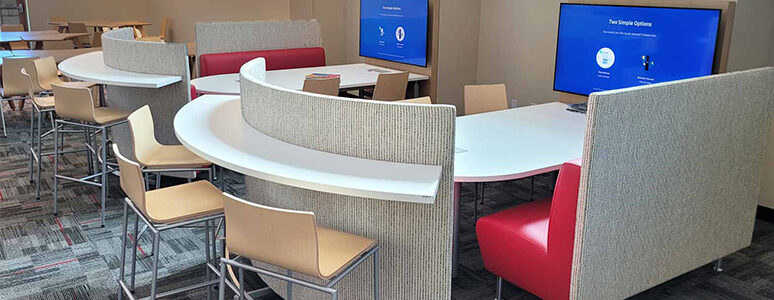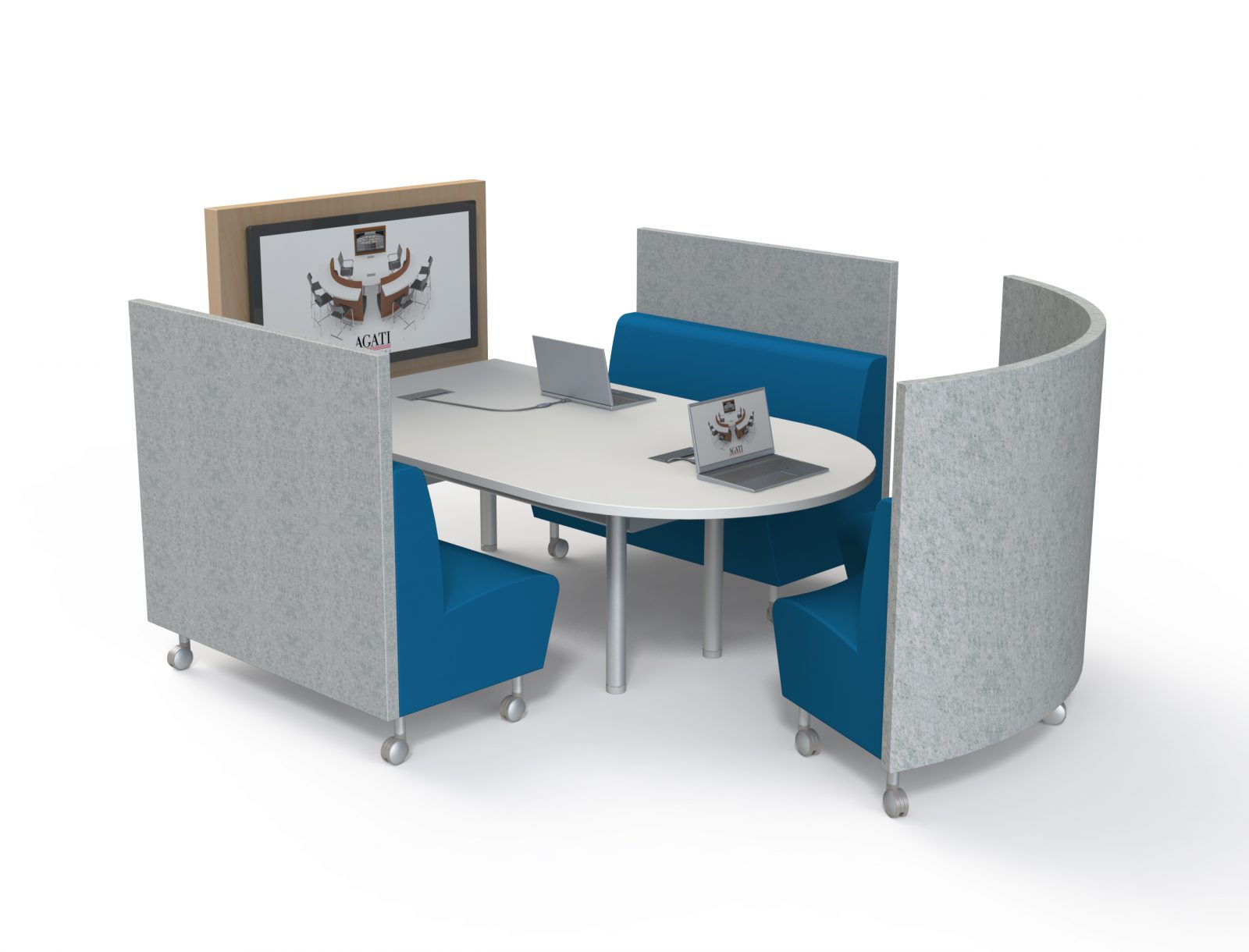
Public spaces evolve to foster positive experiences for their users – both individual and group collaboration alike.
As modern day needs shift, facility designers like ourselves research and identify new methods for creating impactful public spaces such as waiting areas, lounges, community libraries, and student spaces.
By continually studying current seating options supporting group collaboration in public spaces, and identifying gaps, we can solve modern-day problems with knowledgeable furniture and space design.
In this article, we cover three primary problems or opportunities for growth in group spaces:
Problem #1: Group spaces are too centered around technology.
Technology can be a wonderful asset for helping collections of users collaborate. However, it’s not a necessary inclusion for every group space.
In fact, there are many times when a group space needs to support a gathering of people who don’t want or need to use much technology, if any at all.
In plain terms—we’ve overcorrected. Some space designers have gotten such a strong tunnel vision on tech that other important considerations are being sacrificed.
For public spaces that want to cater to the true preferences of their patrons, we recommend shifting your perspective away from technology as the primary focus of every single group space.
Keep your tech, but don’t forget to also keep an open mind so you can curate group spaces that serve the needs of many different users.
Problem #2: Group spaces often lack human-centric design.
If you’re familiar with Agati, you may already know that we study innate human behavior and needs to create furniture that helps people feel confident and comfortable in public spaces.
One of the most important factors in helping your patrons feel comfortable is Refuge—the ability to find haven from the main flow of a space.
READ: Prospect & Refuge: Using Furniture to Create a Biophilic Response
To fulfill their desire for refuge, users seek out furniture that will cover their back, helping them to feel protected, secure, and safe in the place they choose to settle.
Modern public spaces are getting better at providing private space for their single users.
But the key principle of Refuge is often forgotten when group spaces come into the equation.
Just as much as individuals, groups need a strong sense of privacy and a subconscious feeling of shelter in order to feel comfortable and stay productive as they collaborate or work alongside one another.
Does your group space offer back coverings and isolation from the main flow of your space?
Problem #3: Group space does not always mean collaborative space.
Humans naturally like to gather and be around other people. Existing in close proximity with others helps us feel connected.
But that doesn’t mean that every group that sits together is actively collaborating.
Sometimes, friends might seek out a group area that allows them to see and access one another easily even though they are all doing their own separate activities while in the space.
That means it’s smart to offer group spaces that allow people to comfortably work together even if they’re not actually “working together.”
Agati’s Group Space Solutions
In past articles, we’ve gone over the three main “collaboration” work patterns that groups tend to operate in.
READ: 3 Crucial Design Considerations for Your Space in 2024
To sum up our research, we’ve noticed that groups usually either work together around technology, work together with little to no tech involved, or work as a social group, but not on the same problem.
By accommodating these three types of group activities in your space while also ensuring that your group spaces fulfill the human desire for Refuge, you can design a facility that satisfies groups of all shapes and sizes.
If this is a goal you’re interested in pursuing, we recommend the following Agati solutions. (Dive deeper into our collaborative furniture resources here.)
#1: Hampton Collection
Available in straight and curved models as well as modular configurations, our Hampton collection offers many ideal group seating options.
These banquettes empower users to meet and actively converse with one another. They also provide ample space for individuals in a group to work separately without disturbing one another.
While the standard Hampton setup can work well for groups who know one another well, its lack of dividers may be a bit too intimate for patrons who want to be near others but don’t want to sit face-to-face.
That’s why optional surrounds and custom privacy screens can be added to all our Hampton pieces to envelop users and contribute to an improved sense of seclusion.
#2: Elements Media Station
Take the comfortable collaboration space offered by our Hampton seating and combine it with customizable hook-ups for all the technology your users could need.
That’s our Element Media Station and Hampton crossover.
This tech-friendly solution offers the best of both worlds.
Instead of throwing human-centric design principles out the window to accommodate for technology, we maintained the integrity of our original Hampton design while adding in sensible tech solutions like:
- Laptop connections
- Multiple user data options
- A touchscreen for unlimited collaboration
This media station allows users to effortlessly collaborate with members of their group both in-person and remotely.
For ultimate privacy, it can be supplemented with surrounds, creating a bubble that supports an ideal public space for group collaboration.
#3: Gee with Panels
Our Gee Collection is supremely adaptable for group use, and there are many modifications that can be made to these seating solutions to enhance privacy.
These customizations include:
- Chair arms
- Side panels
- Back panels
All of these elements help create a buffer between individuals or groups in a space.
To create even more separation between adjacent groups, the high panels offered by our highly customizable Gee Cove are ideal.
Sector off two or three seats together to create private areas that duos or trios can use to gather and collaborate without feeling exposed to the constant flow of passersby.
#4: POD Duo
For a pair of users who want to work together in a small, secluded sanctuary, there’s no better seating solution than the POD Duo.
Enclosed by upholstered panels, the POD Duo supports group collaboration atmosphere while still providing both users a feeling of refuge and protection by keeping their backs covered and blocking out distractions.
#5: FrameWork Movable Walls
Our FrameWork Whiteboard Partition Walls on Wheels serve a double function:
- They provide a big writing space that groups can use to brainstorm and problem-solve together.
- They function as partitions, or movable walls, that shelter groups and provide optimal privacy with sound reduction.
Our founder, Joe Agati, Sr. developed our FrameWork series after noticing that students in schools and libraries would use flimsy rolling whiteboards to assemble their own makeshift study nooks.
As always, we created this product to solve a problem after observing organic work patterns.
Creating Group Spaces That Offer More Than Just Tech
We encourage you to take a look at your existing or planned group spaces with a new perspective.
To optimize these areas, ask yourself questions like:
- Are my group spaces built around the misconception that people only gather around technology?
- Are my group spaces designed with human behavior and needs (like the desire for privacy) in mind?
- Do I offer spaces that simply allow members of a group to exist together?
With just a few simple tweaks, you can create optimal spaces that give your users a more fulfilling experience that supports a variety of group collaboration.
Want to learn more about our collaborative furniture solutions? Start here.
To dive deeper into the considerations one must keep in mind when designing group spaces, check out Episode 23 of the Agati Video Podcast. In this intriguing conversation, Joe Agati and his guests share their seasoned expertise on designing effective collaboration spaces.








